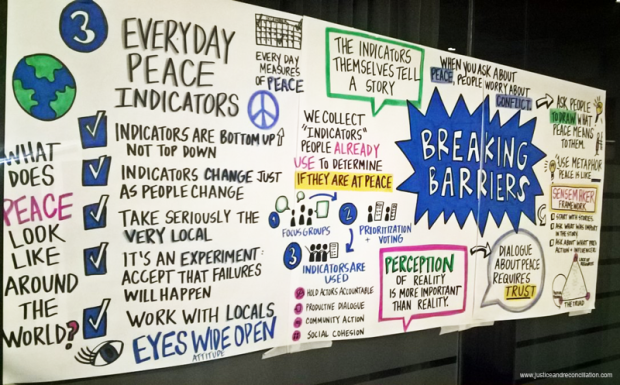“What does peace look like around the world?”
That’s a simple question that can be answered in a couple of ways.
And it was one of many questions we asked in Cape Town this past December during a workshop on breaking barriers to inclusion and participation in peacebuilding evaluation. As an implementing partner of the Everyday Peace Indicators project, JRP was given the opportunity to talk about our work creating a bottom-up approach to evaluating peacebuilding work.
For the past three years, JRP facilitated focus group discussions and community meetings in Kanyagoga, Odek and Atiak to identify indicators to identify those community’s own measures of peace. We followed this up with conducting mobile phone surveys in each location to measure change over time on those indicators.
Possibilities for the future
As the discussion went on, Katherine Haugh an evaluator and graphic designer, created visuals like the one above on the everyday peace indicators, highlighting the questions we were tackling: what does a bottom-up approach to asking how people measure peace in their everyday lives in places like northern Uganda, Zimbabwe and South Africa look like? And what are the possibilities for adopting an approach that focuses on the perspective of the communities in which an intervention is being made, rather than that of an NGO or its donor?
Everyone could walk up and see
As people spoke, Katherine used bright colours to draw and write on boards displayed on the walls of the conference room. At first it was difficult to tell what she was doing and why, but as the process continued it became clear that it was creating an alternative that made what would seem like a complex question (what does peace look around the world?) accessible to all kinds of people. What was great about it was that everyone could walk up and see what she had created during and after the discussions, which made it even more interactive and fun.
Brainstorming new ideas
This different approach was especially important because the whole point of the workshop was to bring actors from across the world to brainstorm and come up with new ideas, be innovative and creative, and share experiences to make sure the communities we partner with are involved in both the work and the evaluation of the work we do. It’s true that not everyone responds to visuals and bright colours – some people are admittedly more aural and like to hear concepts spoken before they can internalise them. But if you’re going to focus on increasing participation and inclusion, this was an incredible way to get the ball rolling.
Read more…
